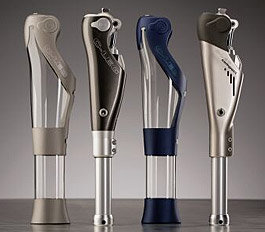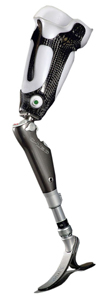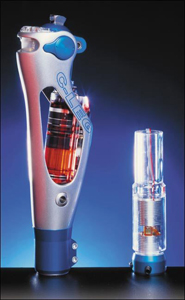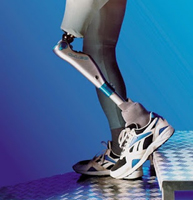Prosthetics
Otto Bock C-Leg

The C-Leg, developed by Otto Bock, is a micro-processor controlled prosthetic knee. First released in 1997, it is said to improve the amputee's gait by allowing a variable cadence and ability to travel over uneven ground. Sensors in the prosthesis provide feedback to the processor, which controls the resistance within the hydraulic cylinder.
In 2004, the C-Leg Compact was introduced. The Compact was designed for amputees with slightly lower mobility levels, and higher needs for stability. It has some differences, such as a different range for Static Stance mode, absence of 2nd mode, and lesser ability to adjust swing phase dynamically.
- Indications
& Benefits - How it
Works - Gait
Biomechanics - Training
Strategies - Precautions
to Use - Links &
References
Indications & Benefits
The indications for the C-Leg are (according to Otto Bock Literature):
- Amputees with an amputation level of knee disarticulation or higher, with a body weight of up to 125kg. Includes amputees with unilateral hip disarticulation amputation, and amputees with hemipelvectomy amputation with good walking ability
- Amputees who have the ability to vary their cadence and to walk fast (> 5 kmph or 3 mph) and/or walk long distances (> 5 km or 3 miles per day). Note the C-Leg may also be recommended for amputees with a lower mobility level where there are other considerations or complications such as bilateral amputees, or those with exacerbations in other conditions caused by the amputation and prosthetic gait patterns
- Amputees walking on uneven ground or slopes or climbing/descending stairs often (> 100 steps per day)
- Persons with professional activities requiring a high level of stance safety, particularly efficient swing phase control and who walk for extended periods
- Amputees who have to change their movements and speed quickly in sudden, unexpected situations (e.g. people responsible for young children)
- Amputees who require the additional modes (e.g. for standing with the knee slightly flexed while weight bearing)
- Amputees able to perform movements which are advantageous for their everyday life and which require flexion of the knee joint under weight bearing, e.g. sitting down, walking on uneven ground, negotiating on slopes and stairs

The main benefits are described as:
- High levels of stance phase stability
- Stumble recovery
- Decreased cognitive demand because of the higher stability and recovery
- Decreased energy consumption compared to mechanical knees
- Ability to descend stairs and slopes step-over-step
- Ability to safely traverse uneven ground
- Swing phase which adapts to the velocity of the user
- A second mode which allows a particular pattern of movement to be pre-programmed, for example, free swinging for cycling, or a sustained flexed position for prolonged standing or certain postures
Kahle et al (2008) found that in comparison between C-Leg and a variety of non-microprocessor controlled knees, that subjects using the C-Leg demonstrated greater prosthesis function and prosthesis-related quality of life, decreased self reported falls and stumbles, increased walking speed, and improvements in stair descent ability. Most subjects preferred the C-Leg to their other knee when asked which knee they would prefer to keep.
Contraindications to prescription of a C-Leg include:
- Amputees with low mobility grades (“indoor walkers”). Some authors expand this to include those who require a walking aid.
- Amputees with cognitive dysfunction, or living situations that do not allow correct handling of the C-Leg.
- Restricted motor capability of the residual limb when controlling the prosthesis, particularly on stairs or inclines.
- Reduced cardiovascular and pulmonary fitness, or reduced balance, which would not allow amputee to take advantage of the benefits of the C-Leg.
How it Works
The C-Leg is a uniaxial knee, allowing flexion up to 125 degrees, and full knee extension movements. There are two sensors which provide feedback to the processor:
- A sensor in the axis of the knee itself, which detects angular position and velocity.
- Sensors, or strain gauges, in the distal end of the tube adaptor, which reports on the direction and size of moments being applied to the foot.

This information is sampled at 50Hz (50 times per second), with the information used to determine the type of action being performed, and then control the amount of hydraulic fluid allowed to pass in or out of the hydraulic cylinder, controlling resistance to flexion and extension.
When the amputee takes weight on the prosthesis, the sensors detect the forces around the foot, and the change in knee position and velocity towards flexion. The processor then acts to increase stance flexion resistance, providing the ability for stance phase stability, stumble recovery, and descent down stairs and slopes. The resistance is usually set so that if there is a stumble, the knee flexes slowly enough to allow the other limb to take a step and recover balance.
At the end of stance phase, the amputee must be able to load the toe with at least 70% body weight. When the knee detects this forefoot load with the knee in extension, the hydraulics disengage stance phase resistance and provide a lower resistance for swing phase. It is thus crucial that the amputee achieve a good terminal stance alignment in order to trigger this change.
Note that the C-Leg automatically re-engages the stance phase flexion dampening as soon as the knee stops flexing in early swing. This ensures knee flexion resistance is available during swing in case the foot catches the floor, for stumble recovery.
There are multiple adjustments that can be made to the hydraulic control, from stance phase flexion and extension resistance, swing phase knee flexion (heel rise) and damping of swing phase terminal extension. Adjustments can be made after real-time analysis of gait, and verbal feedback from the amputee, through a wireless connection to a laptop computer.
The default setting for the C-Leg is a high flexion resistance setting, which is used in the C-Leg Safe Mode. If the battery goes flat or a malfunction occurs, the system defaults to high flexion resistance, providing ongoing stability even though the knee is no longer functioning. This means the amputee can still walk safely, although the knee will not flex for tasks such as sitting down.
The C-Leg is powered by a rechargable lithium-ion battery, housed in the knee axis. The charge can last up to 45 hours, depending on use, but it is recommended that it is charged up overnight. Charging time can be up to 5 hours.
The frame is made of carbon fibre, providing both strength and a light weight. It acts to house and protect the battery, cylinder, and electronics.
The C-Leg has several modes:
- First mode, which is programmed for the wearer's everyday activity, such as walking.
- Second mode, which can be programmed with one other type of activity which requires a different level of resistance, such as cycling, skating, or standing in flexion.
- A third mode, added with the 2011 model C-Leg, giving the user a third personalised functional setting.
The amputee can switch between these modes by either using their remote, or bouncing on their toes with the knee extended.
The remote can also be used to access Static Stance mode, where the knee is 'locked' at a particular angle of flexion. Static Stance allows the amputee to stand with less energy consumption, and can be set anywhere from 7-70 degrees in the C-Leg, and 0-30 degrees in the Compact. In the C-Leg, Static Stance mode can also be accessed by flexing the knee and then straightening it to the desired angle (although this method is not available in the Compact).
The C-Leg can be used with a range of prosthetic feet, from energy storing carbon fibre, to static feet.
Gait Biomechanics
Gait biomechanics are described on our Transfemoral Gait Biomechanics page. Differences with the C-Leg compared to other knees are highlighted where relevant.
Training Strategies
Instructional materials, including documents and videos, are available on the Otto Bock Website.
For training gait with the C-Leg, two main concepts are generally described as the most crucial:
- Teaching knee yield, so the amputee trusts the knee joint to support them even though it may be flexing.
- Teaching correct terminal stance alignment and forefoot loading, in order to trigger the transition from stance stability to swing phase.
Knee flexion during the loading response helps to absorb impact, and limits the vertical movement of the centre of mass. This action can be disconcerting to amputees, where knee flexion is usually the sign that a fall is about to occur. The amputee must learn how to engage the stance flexion resistance through correct timing of the loading response, getting a feel for how the knee responds with changes in load and velocity during weight acceptance. Damping of stance flexion may start relatively high, but be reduced over time as trust and skill improves. The amputee should be taught to load the prosthesis in a more normal fashion, reducing the excessive hip extension which is typically required to lock mechanical knees safely into extension.

The ability to engage stance flexion resistance is necessary for stumble recovery, and for more advanced skills such as walking down slopes or down stairs step-over-step, where the amputee 'rides' the knee down, while the hydraulics resist gravity and the tendancy to buckle. Therefore, if stumbles or buckling occur, the amputee must be taught to load the knee, rather than the automatic response of avoiding weight bearing.
Teaching correct terminal stance extension and toe loading is crucial for triggering the switch from stance phase resistance, to free swinging. The amputee must load the forefoot with at least 70% body weight, with the knee extended, in order to trigger the transition. This may be particularly difficult in cases where the amputee has used other knee mechanisms where the knee is 'locked' in extension while weight is borne on it, and the transition to swing involves unloading the prosthesis. The amputee here may use habitual patterns such as hitching, vaulting, or excessive hip flexion to initiate swing phase. However, C-Leg users must be taught to maintain correct extension through late stance, keep load on the forefoot, and reduce the amount of active hip flexion. In fact, the initiation of swing should be thought of as being created by hip extension, rather than flexion. Adequate hip extension range is also critical here.
Over time, many Physiotherapists and Prosthetists have suggested strategies which they found useful in training amputees to use the C-Leg efficiently and effectively. These strategies are summarised in our Gait Analysis and Training Portal.
Some authors report that it may take up to two months to become acclimatised to walking with the C-Leg, particularly after previously using mechanical knees or walking aids. It is normal that the settings will have to be adjusted by the prosthetist as the amputee's mobility improves.
Above all, it is important to consider the amputee's goals when prescribing training strategies, much like training amputees with other types of prostheses, or no prosthesis at all. Training other skills, such as standing up, getting up & down from the floor, walking backwards or sideways, getting in & out of cars, carrying loads, or bending to reach cupboards should form a part of the program if the amputee has goals along these lines. Cardiovascular fitness is also important, due to the higher energy consumption required during prosthetic gait. Training strategies here, however, describe only those associated with gait. See the Training page for ideas on training other skills.
Precautions to Use
- The 2011 model C-Leg has a weight capacity of 300lbs (approx 135kg), although this reduces depending on other components, such as pylons.
- Walking backwards - loading the toe during the backward step may disengage the stance phase stability.
- Walking upstairs - ensure the midfoot & heel are in contact with the step. Loading the forefoot may disengage the stance phase stability.
- Check which mode the amputee is in before walking, to ensure normal stance and swing phase functions are operational.
- The knee may malfunction if exposed to excessive loads, water, dirt, magnetic interference, and high temperatures. Extended periods of use such as walking downhill can also overheat the hydraulic unit.
- Note that the C-Leg also has a Safety Mode. Any critical error in the system should activate Safety Mode, which defaults to a state of high flexion damping, and allows the patient to still walk despite a failure in the system.
Links
More C-leg videos are available on YouTube. Remember that some Area Health Services have blocked access to YouTube, so you may not see the video embedded below, which shows a promotional video of a bilateral transfemoral amputee using the C-Leg. If you wish to see it elsewhere, the link is youtu.be/r5FDkLhbDb0
References
- Otto Bock C-Leg. www.ottobock.com.au/prosthetics/lower-limb/lower-limb-overview/c-leg/
- Kahle JT, Highsmith MJ & Hubbard SJ (2008). Comparison of nonmicroprocessor knee mechanisms versus C-Leg on Prosthesis Evaluation Questionnaire, stumbles, falls, walking tests, stair descent and knee preference. Journal of Rehabilitation Research & Development, 45, 1, 1-14.
- Kastner K, Nimmervoll R, Kristen H, Wagner P (1999). “What are the benefits of the C-Leg?” A comparative gait analysis of the C-Leg, the 3R45 and the 3R80 prosthetic knee joints. Medizinisch Orthopädische Technik 119, 131-137
- Orendurff M, Segal A, McDowell M, Klute G, Williams R, Turner A, Pecoraro J, Czerniecki J (----). C-Leg does not improve stance phase knee flexion or walking efficiency in older transfemoral amputees. ISB XXth Congress - ASB 29th Annual Meeting, July 31 - August 5, Cleveland Ohio.
- Segal, AD et al (2006). Kinematic and kinetic comparisons of transfemoral amputee gait using C-Leg® and Mauch SNS® prosthetic knees. Journal of Rehabilitation, Research & Development, 43, 7, 857-870.
Information compiled by Tony Fitzsimons, June 2010.
Updated January 2012.